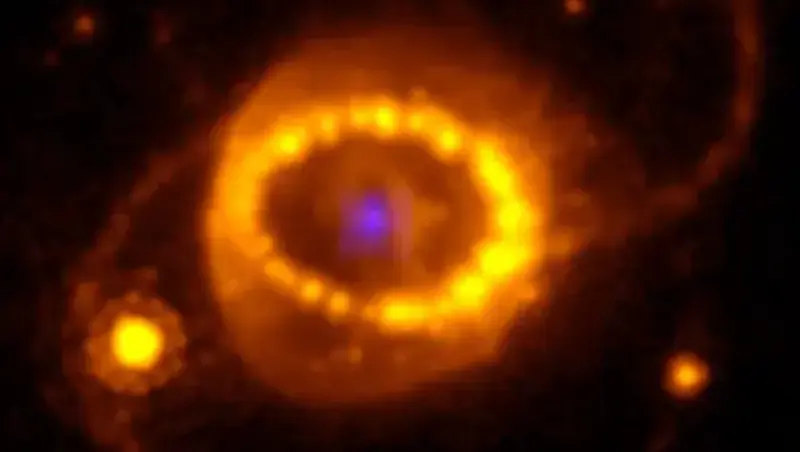Eye of Sauron supernova detected by JWST space telescope
- February 23, 2024
- 0
It may look like the Eye of Sauron, but the tiny blue-violet sphere pictured above is actually an incredibly dense neutron star surrounded by stellar debris. The image
It may look like the Eye of Sauron, but the tiny blue-violet sphere pictured above is actually an incredibly dense neutron star surrounded by stellar debris. The image

It may look like the Eye of Sauron, but the tiny blue-violet sphere pictured above is actually an incredibly dense neutron star surrounded by stellar debris. The image is a combination of photographs taken by the James Webb Space Telescope (JWST) and the Hubble Space Telescope and marks the moment when an international team of astronomers found a small neutron star hidden inside a giant supernova that exploded 37 years ago.
This star explosion, called Supernova 1987A, is the best-studied supernova and the brightest of the last 400 years. A few months before his disappearance, he was visible even to the naked eye. But what remained hidden at its center was a source of mystery for nearly four decades.
Supernovae occur when a star 8-10 times larger than our Sun collapses with a spectacular explosion. A collapsing core usually collapses into a smaller neutron star (which consists of the densest matter in the universe). It’s either a black hole.
However, despite indications that a neutron star may have formed, no compact object was found inside Supernova 1987A. Neutrinos (incredibly tiny subatomic particles) were detected on Earth on February 23, 1987, the day before the explosion. A large dust cloud blocked visible light from escaping from its center, leading to the biggest unsolved problem in supernova research.
New research published in the journal Science, was finally able to see this dust cloud by observing it in infrared. Using JWST, researchers detected heavy atoms of argon and sulfur near the site of the supernova explosion, with their outer electrons ionized or literally knocked off.
Researchers say this effect can only be caused by a neutron star. Ionization occurred either as the star rotated rapidly and dragged particles around itself, or from ultraviolet and
Study co-author Professor Josephine Larsson said: “This supernova continues to surprise us. No one could have predicted that a compact object would be detected via the ultra-strong argon emission line, so it’s a bit funny that we found it this way at JWST.”
Source: Port Altele
As an experienced journalist and author, Mary has been reporting on the latest news and trends for over 5 years. With a passion for uncovering the stories behind the headlines, Mary has earned a reputation as a trusted voice in the world of journalism. Her writing style is insightful, engaging and thought-provoking, as she takes a deep dive into the most pressing issues of our time.